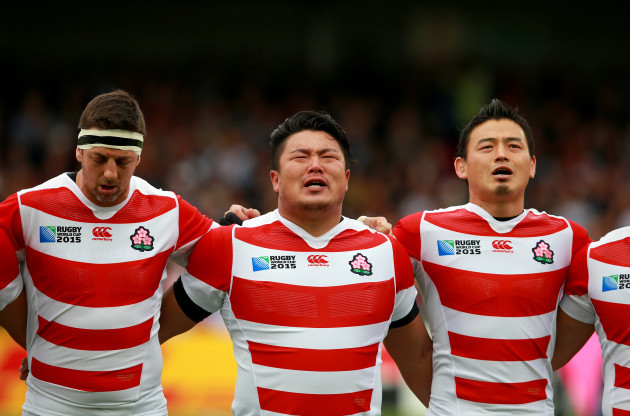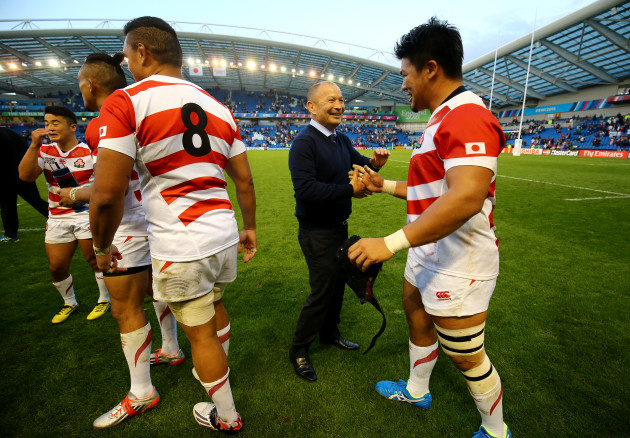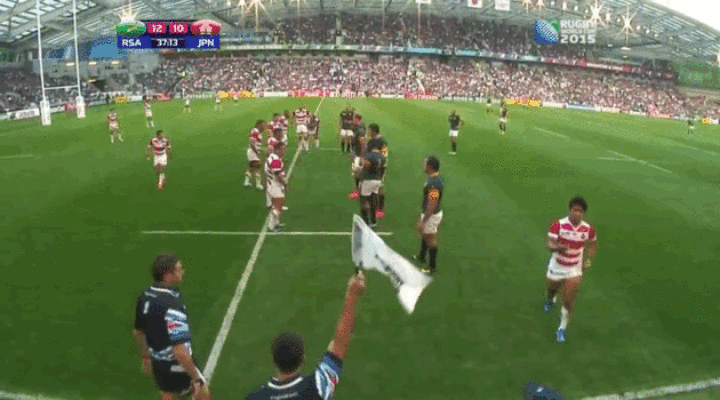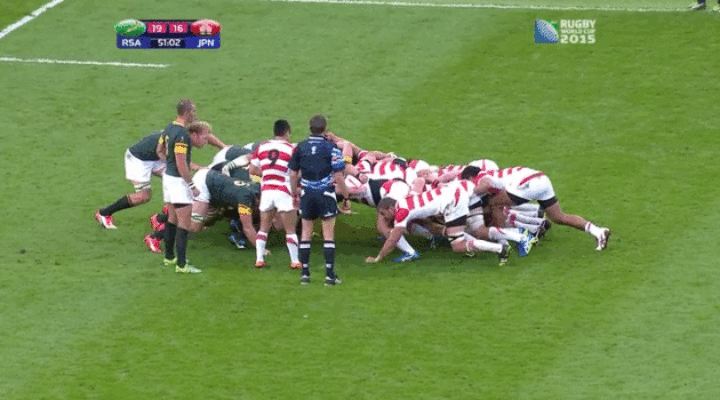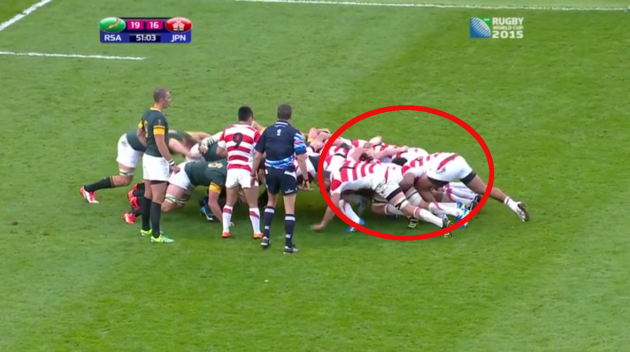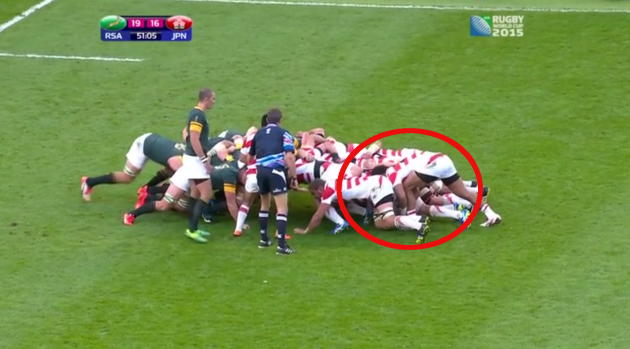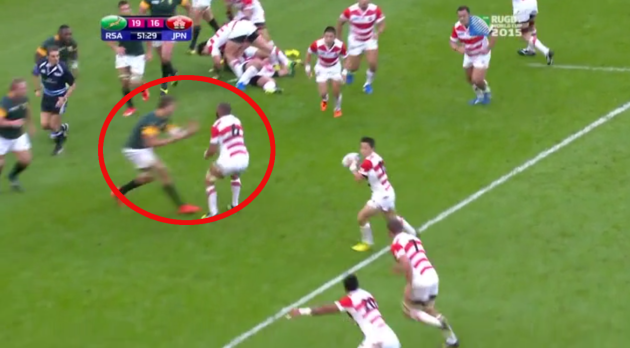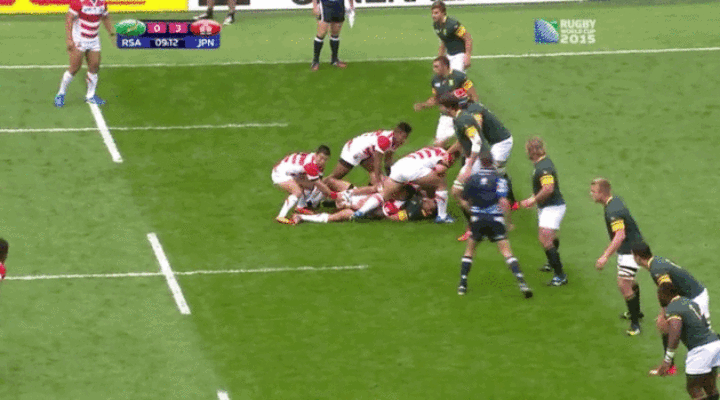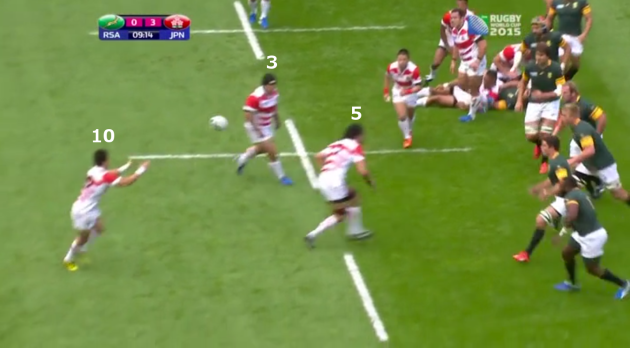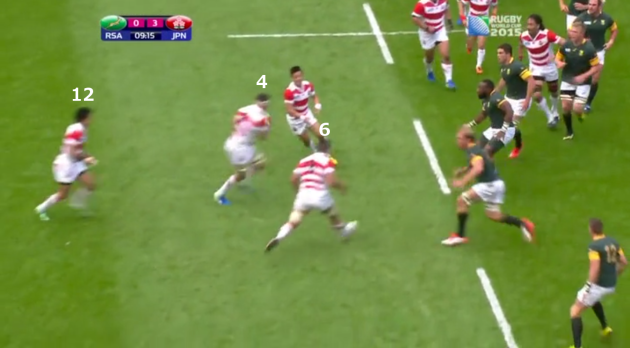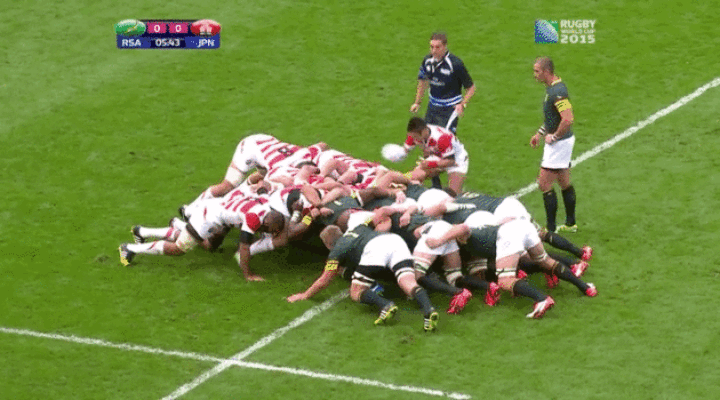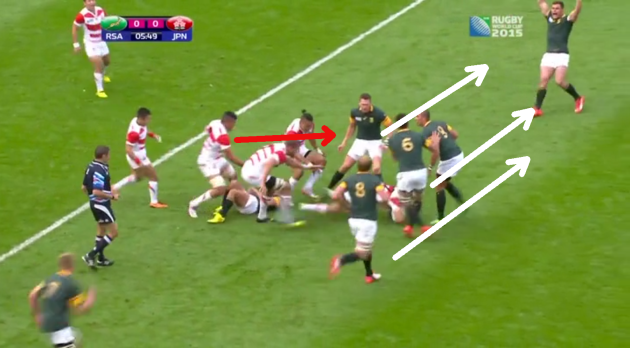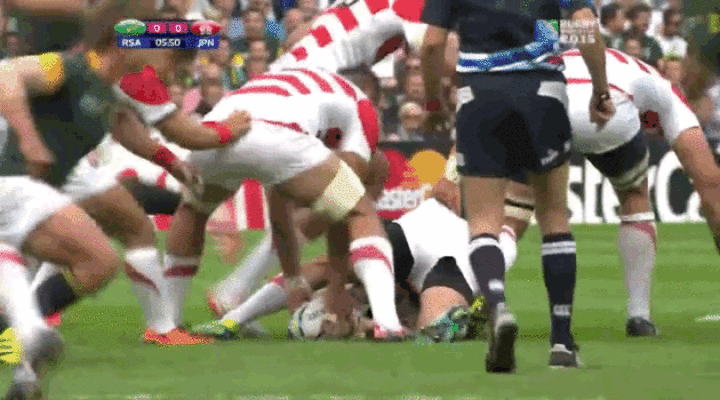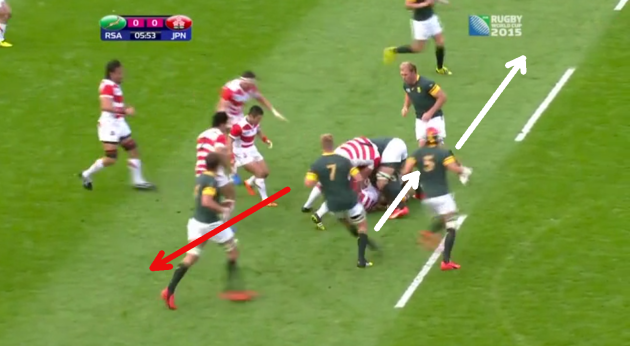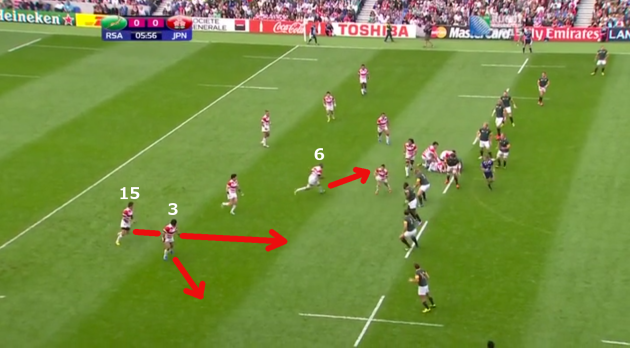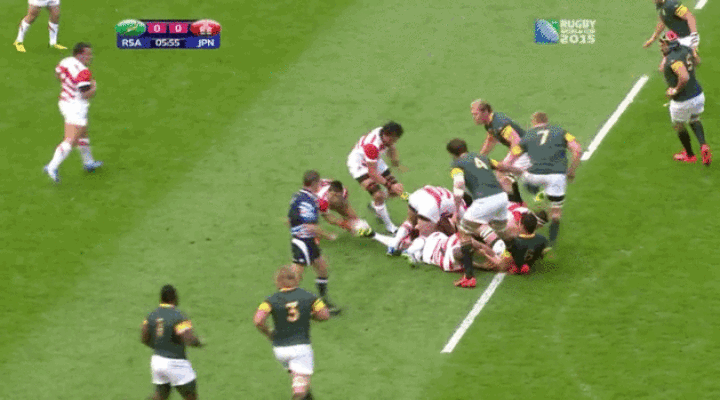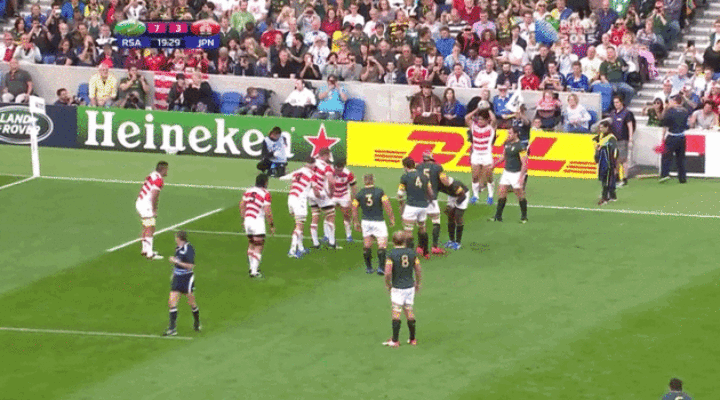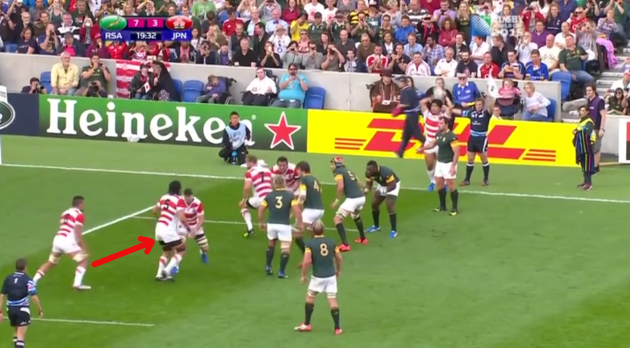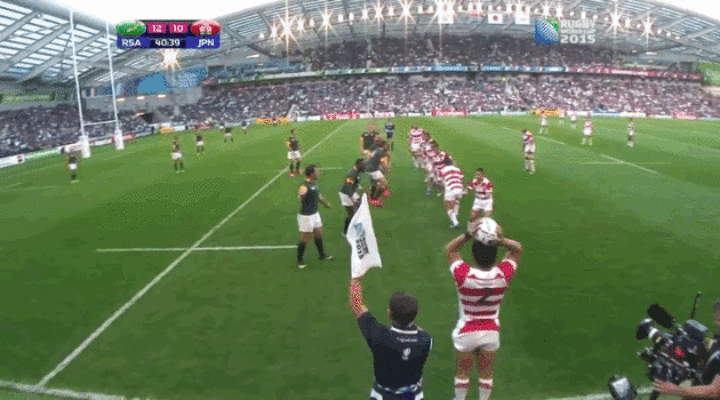BEFORE WE BEGIN, it’s worth stressing that Japan’s shock victory over South Africa was achieved because of the mindset, commitment and competence of their players on the pitch in Brighton.
The decision to pursue the winning try – when the coaching staff had relayed a message to kick at goal and take the draw – highlights as much. These players have utterly deserved the plaudits they’ve received since last weekend’s result.
The bubble of hype deflated a little on Wednesday with the defeat to Scotland, though the cruel scheduling of the World Cup played a part in that. That’s another issue that has been discussed repeatedly elsewhere, this is not the place for it.
Instead, we are looking at the quality of coaching and thought behind Japan’s efforts at this World Cup and over the last four years or so.
The win over South Africa did not simply come from nowhere, it was the result of the hard work Japan have done under Eddie Jones over recent seasons. That said, it was the shock to end all shocks, a result that will never been forgotten.
More impressively, it’s a performance that will never be forgotten. It also serves as huge inspiration for sides who concede the weight and strength advantage to their opponents, and must look to do things slightly differently.
Jones and Japan have thought outside the box.
The most revealing and interesting quote we’ve heard or read so far during this tournament came in Clive Woodward’s superb interview with Jones for MailOnline. Asked about the speed of Japan’s play and their handling quality, Jones had this to say:
“Every week we have a full-on, 30-minute session in which we do everything between 40-60% quicker than in a normal game. It’s like speeding the film up.
“If you can handle under that pressure then mentally it feels just a bit easier when you play at match speed.”
One of American football’s most fascinating coaches, Chip Kelly of the Philadelphia Eagles, does something very similar with his team, running play after play with extremely limited time in between, forcing his players to think and execute under pressure, fatigue and without constant feedback from the coaching staff.
The result of Japan’s approach in these 30-minute sessions is obvious in the lightning pace of their attacking play. The strength and conditioning team clearly deserve major credit in this speed of play being possible of course.
Everything about Japan is built on the premise of speed.
Above we see a typical example of what Japan did against South Africa, with hooker Shota Horie attempting to take the Springboks by surprise and get the ball in before they can react.
It’s obviously unsuccessful, but it highlights an important part of the thought process from Japan. They don’t always do this at lineout time, but there are many occasions on which they looked to beat the Boks with straightforward speed.
Another fine example comes at the scrum, with the use of channel one ball against the heavy South African pack.
Channel one ball entails the ball being hooked between the loosehead prop’s legs and down the left (near) side of the scrum to the number eight’s left. It provides rapid possession and can sometimes negate the scrum contest when done successfully.
Above, we get a superb example as the ball enters and leaves the scrum in the blink of an eye.
Watch how it travels between the loosehead’s legs down that left-hand side and also note the actions of the sublime number eight Amanaki Lelei Mafi, who was cruelly injured against Scotland.
Mafi begins by engaging in between his second rows, as above, but immediately bounces to his left and dips his hands into the scrum, ready to accept the swiftly-hooked ball.
The ball arrives and within a split second Mafi has stood and passed it away. South Africa are immediately forced to react and shift, meaning any intention of powering forward at the scrum is cancelled out.
Canada did something similar against Ireland on a few occasions last weekend, and it’s a good tactic for negating the scrumming strength of an opponent.
Intriguingly, as Japan’s game against the Boks continued, they were increasingly happy to leave the ball in and ensure a contest. They even ended up in a dominant position in the closing stages, a sign of the belief flowing in their minds.
The influence of former France hooker Marc del Maso is stamped all over this forward unit, with their speed and intelligence symbolic of what Japan have done in recent times.
Japan’s phase play moves at an extreme pace, largely thanks to their rucking quality. Jones’ side prove that you don’t need to be the biggest team in the world to clear out rucks.
They often commit three men to a ruck to ensure it’s won and won at speed, similarly to Ireland, while their aggression and technical strength in shifting bodies points to repeated training ground practice, the only way to improve rucking.
The result is often quick ball for clever scrum-half Fumiaka Tanaka, and there is almost always some sort of basic shape either side of him.
In this instance it’s something as simple as screen passing behind captain Michael Leitch, with the back row drawing South Africa’s Lood de Jager up into the tackle and then just hanging onto him for a split second after they make contact to tie him down.
The above is exactly the shape that Japan used in scoring the winning try against South Africa, although on that occasion it was fullback Ayumu Goromaru who ran the decoy line.
Jones has his players always thinking on their feet as they move. ‘What can I do here to challenge the defence? How can I create space for a teammate? How can I take responsibility rather than letting someone else do the dog work?’
Japan’s handling at pace was exceptional in the win over South Africa, particularly given that they play so flat to the line.
Above, we see some simple shape close to the ruck again as Tanaka fires a tunnelled pass between Kensuke Hatakeyama (3) and lock Hitoshi Ono (5) to out-half Kosei Ono.
Outside Ono is another nice little shape, one that asks questions of the Springbok defence. Leitch (6) and Luke Thompson (4) are the forward runners, while centre Harumichi Tatekawa (12) shows for the back door option.
While they do have some excellent ball carriers, Jones has been aware that Japan have to show more than simple one-put play to get over the gainline and unsettle the defence. We see the thought process working here as Schalk Burger shoots up and leaves space for Thompson to run into.
Japan resource the subsequent ruck with three players and then move back to the left at speed, again lying incredibly flat and testing their skills under intense pressure.
Horie comes with an excellent response, laying off the loop pass to Tanaka, and once again Japan are putting the pressure back on South Africa. These little shapes and mini-plays are hugely effective when done at pace.
Jones and his coaching staff have ensured the players are prepared to do exactly that.
Power plays
Japan play a programmed brand of rugby, but one that comes across as being full of flair, enthusiasm and pace. Jones has spoken before of how obedient he has found the Japanese players to be, meaning they are fully suited to multi-phase power plays.
The example below is a fine one, though Japan ran many, many more mapped-out power plays against South Africa and Scotland.
Scrum deep inside their own half? That’s an opportunity to attack for Japan, who use channel one in the scrum and play away to the left with a direct carry from inside centre Tatekawa.
Aware that South Africa will be attempting to fold hard around the corner of that ruck, number eight Hendrik Tui scoops up the ball after a lightning quick ruck and drives forward.
The South Africans are still looking to fold around to the right, allowing Jones’ men to bounce back against the grain to the left, as they have mapped out for themselves on this attack.
When Tanaka does come back to South Africa’s left, the shape is again wonderful. Every player understands his role in detail and executes superbly.
Leitch (6) is tasked with running the dummy switch inside Tanaka, while tighthead prop Hatakeyama (3) runs across the front of fullback Goromaru (15), who is the target if all goes according to plan.
In front of the Japan attack at this stage is the entire South Africa front row, exactly as Jones and his players would have planned for. This power play gets Goromaru into a genuine one-on-one with Boks hooker Bismarck du Plessis and he exploits it.
Tanaka is key to the success of this play, buzzing to the rucks and then attracting in Tendai Mtawarira before releasing the pass to Goromaru.
If Goromaru gives the pass to right wing Akihito Yamada on his shoulder after stepping and breaking, the try is very likely. Japan go on to win a penalty on the very next phase and a highly-stressed Boks defence comes offside, but it could have been more.
There have been many more examples of clever attack off the set-piece from Japan in their two opening games and over the course of recent seasons, but the point here is that a pre-planned and repeatedly-drilled attack can free up players to use their skills.
On first watch, it might look like inspiration from Goromaru – which it is, in part – but this attack is about each player understanding and executing their role. Even against a bigger team, that is a major advantage.
Lineout
Steve Borthwick is reportedly heading to Bristol after this World Cup, and the English side have invested in a high-quality coach if that is the case.
The former Saracens lock has developed a hugely intelligent lineout system with Japan to ensure that their physical disadvantages are usually negated.
Above, we get a nice example. Japan are inside their own 22 and clearly want to exit as comfortably as possible. They’re well aware that South Africa will get into the air to compete, so they use a little bit of intelligence to get out safely.
It’s a four-man lineout, Japan dummy at the front and then send Hitoshi Ono and Thompson towards the tail. South Africa don’t see a three-man pod there, with no lifter at the back of Ono, and remain just in front of Thompson, also covering Michael Broadhurst.
In steps Tui from the receiver position, providing that lift at the back of Ono and Japan win easy ball. Clean, simple, effective.
Below, Japan again want to win quick ball at the front of the lineout to launch an attack, and give themselves an advantage by using Tanaka to draw Mtawarira away from being part of the lifting pod on de Jager.
With Tanaka showing for a possible short throw from Horie, Mtawarira feels he can’t simply line up for a lift at the front of de Jager. It means the lock is lacking a little height when he gets up to compete, and Tui is able to win it cleanly.
Tanaka steps out to accept ball off the top and Japan are away again at speed.
We could go through countless different lineout moves and patterns here, but the point is that Borthwick and Japan have used simple, intelligent ideas to increase their chances of winning lineout ball.
Aware that their jumping options are not as explosive in the air as some of the opposition’s, they manipulate the defence to create spaces and opportunities.
That doesn’t apply only to their lineout play of course. This Japan side bears all the hallmarks of a clever coaching team working as best they can with the resources they’ve been presented with.
Intelligence can often outweigh bulk and power. That can be applied to scrum, maul, lineout, phase play, set-piece strikes, and everything else involved in the game.
Originally published at 0630
